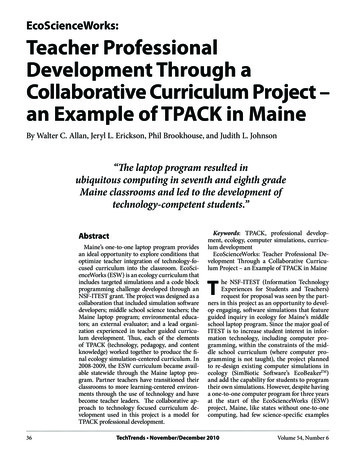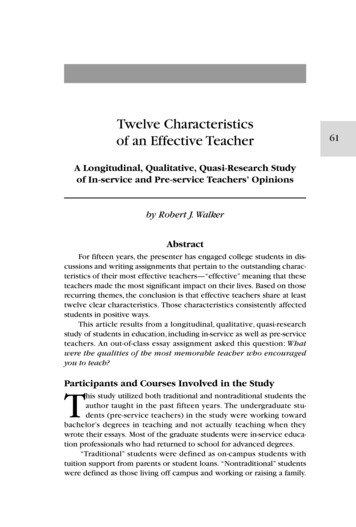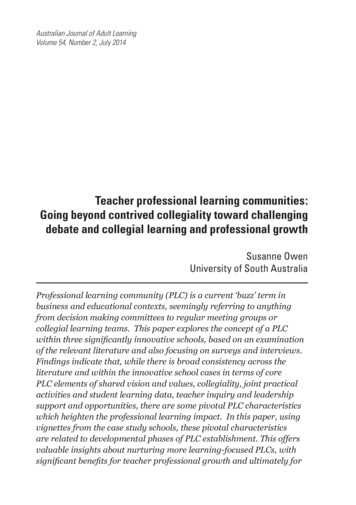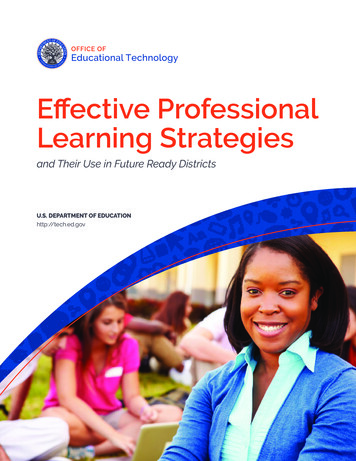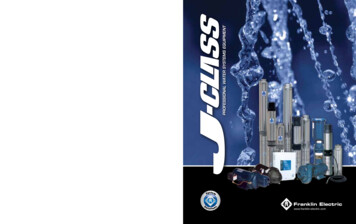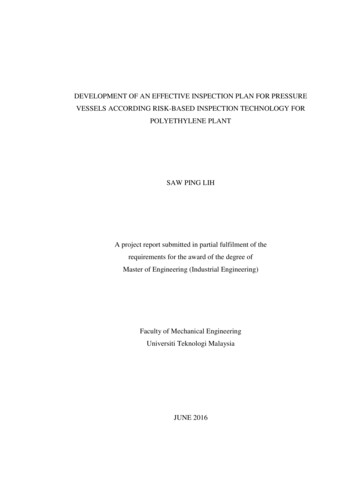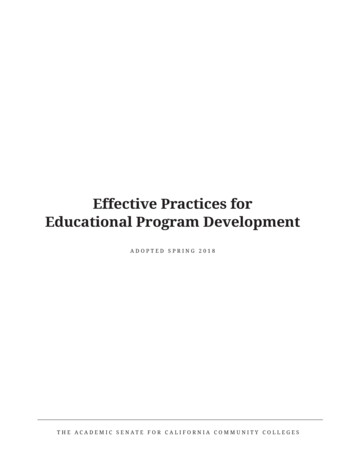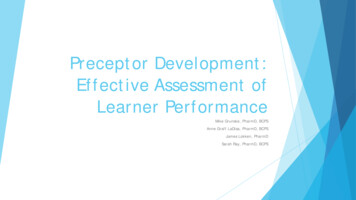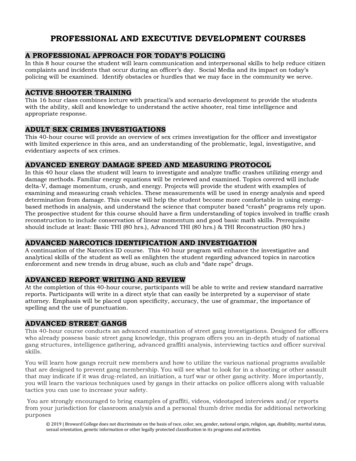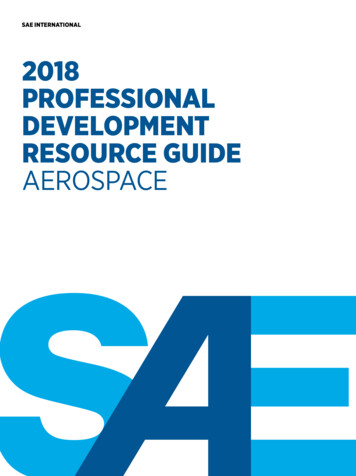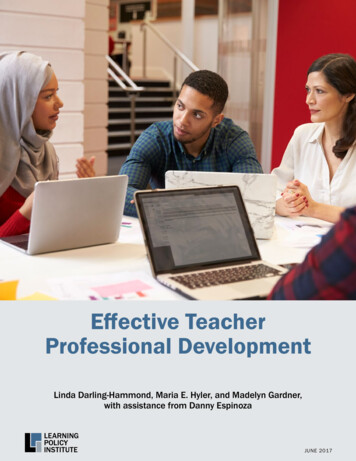
Transcription
Effective TeacherProfessional DevelopmentLinda Darling-Hammond, Maria E. Hyler, and Madelyn Gardner,with assistance from Danny EspinozaJUNE 2017
Effective TeacherProfessional DevelopmentLinda Darling-Hammond, Maria E. Hyler, and Madelyn Gardner,with assistance from Danny Espinoza
AcknowledgmentsThe authors would like to thank their LPI colleagues Jessica Cardichon and Kathryn Bradley for theircontributions to the research and writing of this paper. We also thank Naomi Spinrad and PenelopeMalish for their editing and design contributions to this project, and Lisa Gonzales for overseeingthe editorial process. Without the generosity of time and spirit of all of the aforementioned, thiswork would not have been possible.The S. D. Bechtel, Jr. Foundation and the Sandler Foundation have provided operating support forthe Learning Policy Institute’s work in this area.External ReviewersThis report benefited from the insights and expertise of two external reviewers: Laura Desimone,Associate Professor, Education Policy, Penn Graduate School of Education; and Michael Fullan, formerDean of the Ontario Institute for Studies in Education, University of Toronto. We thank them for thecare and attention they gave the report. Any remaining shortcomings are our own.The appropriate citation for this report is: Darling-Hammond, L., Hyler, M. E., Gardner, M. (2017).Effective Teacher Professional Development. Palo Alto, CA: Learning Policy Institute.This report can be found online at r-prof-dev.This work is licensed under the Creative Commons Attribution—NonCommercial 4.0 InternationalLicense. To view a copy of this license, visit RNING POLICY INSTITUTE EFFECTIVE TEACHER PROFESSIONAL DEVELOPMENTii
Table of ContentsAcknowledgments. iiExecutive Summary. vIntroduction.1Defining Effective Professional Development.2This Study.2Goals and Outline of This Report.3Design Elements of Effective Professional Development.4Content Focus.5Active Learning.7Collaboration.9Use of Models and Modeling. 11Coaching and Expert Support. 12Feedback and Reflection. 14Sustained Duration. 15Realizing the Promise of Professional Learning Communities. 17The Benefits of Analyzing Student Work and Student Data. 17Learning From Professional Communities Beyond the School. 18Creating the Conditions for Effective Professional Development:Opportunities and Challenges. 20School Level. 20System Level. 21Conclusions and Policy Implications. 23Implications for Policy. 23Implications for Implementation and Practice. 24Appendix A: Methodology. 25Appendix B: Summary of Studies Reviewed for This Report. 27Appendix C: Elements of Effective Professional Development by Study. 48Endnotes. 53About the Authors. 64LEARNING POLICY INSTITUTE EFFECTIVE TEACHER PROFESSIONAL DEVELOPMENTiii
LEARNING POLICY INSTITUTE EFFECTIVE TEACHER PROFESSIONAL DEVELOPMENTiv
Executive SummaryTeacher professional learning is of increasing interest as one way to support the increasinglycomplex skills students need to learn in preparation for further education and work in the 21stcentury. Sophisticated forms of teaching are needed to develop student competencies suchas deep mastery of challenging content, critical thinking, complex problem-solving, effectivecommunication and collaboration, and self-direction. In turn, effective professional development(PD) is needed to help teachers learn and refine the pedagogies required to teach these skills.However, research has shown that many PD initiatives appear ineffective in supporting changes inteacher practices and student learning. Accordingly, we set out to discover the features of effectivePD. This paper reviews 35 methodologically rigorous studies that have demonstrated a positive linkbetween teacher professional development, teaching practices, and student outcomes. We identifythe features of these approaches and offer rich descriptions of these models to inform those seekingto understand the nature of the initiatives.Defining and Studying Effective Professional DevelopmentWe define effective professional development as structured professional learning that results inchanges in teacher practices and improvements in student learning outcomes. To define featuresof effective PD, we reviewed studies meeting our methodological criteria (see Appendix A) thatemerged from our extensive search of the literature over the last three decades. We coded each ofthe studies to identify the elements of effective PD models.Using this methodology, we found seven widely shared features of effective professionaldevelopment. Such professional development:Is content focused: PD that focuses on teaching strategies associated with specific curriculumcontent supports teacher learning within teachers’ classroom contexts. This element includes anintentional focus on discipline-specific curriculum development and pedagogies in areas such asmathematics, science, or literacy.Incorporates active learning: Active learning engages teachers directly in designing and tryingout teaching strategies, providing them an opportunity to engage in the same style of learning theyare designing for their students. Such PD uses authentic artifacts, interactive activities, and otherstrategies to provide deeply embedded, highly contextualized professional learning. This approachmoves away from traditional learning models and environments that are lecture based and have nodirect connection to teachers’ classrooms and students.Supports collaboration: High-quality PD creates space for teachers to share ideas and collaboratein their learning, often in job-embedded contexts. By working collaboratively, teachers cancreate communities that positively change the culture and instruction of their entire grade level,department, school and/or district.Uses models of effective practice: Curricular models and modeling of instruction provideteachers with a clear vision of what best practices look like. Teachers may view models thatinclude lesson plans, unit plans, sample student work, observations of peer teachers, and video orwritten cases of teaching.LEARNING POLICY INSTITUTE EFFECTIVE TEACHER PROFESSIONAL DEVELOPMENTv
Provides coaching and expert support: Coaching and expert support involve the sharing ofexpertise about content and evidence-based practices, focused directly on teachers’ individual needs.Offers feedback and reflection: High-quality professional learning frequently provides built-intime for teachers to think about, receive input on, and make changes to their practice by facilitatingreflection and soliciting feedback. Feedback and reflection both help teachers to thoughtfully movetoward the expert visions of practice.Is of sustained duration: Effective PD provides teachers with adequate time to learn, practice,implement, and reflect upon new strategies that facilitate changes in their practice.Our research shows that effective professional learning incorporates most or all of these elements.We also examine professional learning communities (PLCs) as an example of a PD model thatincorporates several of these effective elements and supports student learning gains. Thiscollaborative and job-embedded PD can be a source of efficacy and confidence for teachers, and canresult in widespread improvement within and beyond the school level.Creating Conditions for Effective Professional Development: Opportunitiesand ChallengesResearch has established that the educational system within which PD occurs has implications forits effectiveness. Specifically, conditions for teaching and learning both within schools and at thebroader, system level can inhibit the effectiveness of PD. For example, inadequate resourcing forPD—including needed curriculum materials—frequently exacerbates inequities and hinders schoolimprovement efforts. Failure to align policies toward a coherent set of practices is also a majorimpediment, as is a dysfunctional school culture. Implementing effective PD well also requiresresponsiveness to the needs of educators and learners and to the contexts in which teaching andlearning will take place.Implications for Policy and PracticeExamples of PD that have been successful in raising student achievement can help policymakersand practitioners better understand what quality teacher professional learning looks like. Policy canhelp support and incentivize the kind of evidence-based PD described here. For instance:1. Policymakers could adopt standards for professional development to guide the design,evaluation, and funding of professional learning provided to educators. These standardsmight reflect the features of effective professional learning outlined in this report as well asstandards for implementation.2. Policymakers and administrators could evaluate and redesign the use of time and schoolschedules to increase opportunities for professional learning and collaboration, includingparticipation in professional learning communities, peer coaching and observations acrossclassrooms, and collaborative planning.3. States, districts, and schools could regularly conduct needs assessments using datafrom staff surveys to identify areas of professional learning most needed and desiredLEARNING POLICY INSTITUTE EFFECTIVE TEACHER PROFESSIONAL DEVELOPMENTvi
by educators. Data from these sources can help ensure that professional learning is notdisconnected from practice and supports the areas of knowledge and skills educators wantto develop.4. State and district administrators could identify and develop expert teachers as mentorsand coaches to support learning in their particular area(s) of expertise for other educators.5. States and districts can integrate professional learning into the Every StudentSucceeds Act (ESSA) school improvement initiatives, such as efforts to implementnew learning standards, use student data to inform instruction, improve student literacy,increase student access to advanced coursework, and create a positive and inclusivelearning environment.6. States and districts can provide technology-facilitated opportunities for professionallearning and coaching, using funding available under Titles II and IV of ESSA to addressthe needs of rural communities and provide opportunities for intradistrict and intraschoolcollaboration.7. Policymakers can provide flexible funding and continuing education units for learningopportunities that include sustained engagement in collaboration, mentoring, andcoaching, as well as institutes, workshops, and seminars.In the end, well-designed and implemented PD should be considered a essential component of acomprehensive system of teaching and learning that supports students to develop the knowledge,skills, and competencies they need to thrive in the 21st century. To ensure a coherent system thatsupports teachers across the entire professional continuum, professional learning should link totheir experiences in preparation and induction, as well as to teaching standards and evaluation. Itshould also bridge to leadership opportunities to ensure a comprehensive system focused on thegrowth and development of teachers.LEARNING POLICY INSTITUTE EFFECTIVE TEACHER PROFESSIONAL DEVELOPMENTvii
LEARNING POLICY INSTITUTE EFFECTIVE TEACHER PROFESSIONAL DEVELOPMENTviii
IntroductionAs demands for deeper and more complex student learning have intensified, practitioners,researchers, and policymakers have begun to think more systematically about how to improveteachers’ learning from recruitment, preparation, and support, to mentoring and other leadershipopportunities. Sophisticated forms of teaching are needed to develop 21st century studentcompetencies, such as deep mastery of challenging content, critical thinking, complex problemsolving, effective communication and collaboration, and self-direction. In turn, opportunities areneeded for teachers to learn and refine the pedagogies required to teach these skills.However, major questions remain about howSophisticated forms of teachingteachers can learn these skills and how PD canplay a role in improving teacher practice. Recentare needed to develop 21stresearch on PD has underscored the importancecentury student competencies.of these questions, given the mixed findingsoften generated.1 For example, one recent studyof four districts serving a largely low-incomestudent population found that even with large financial investments in teacher PD, both teacherpractice (according to teacher evaluations) and student learning (according to state assessments)saw little change. The study found that teacher evaluations stayed the same, or declined in the spanof 2-3 years, while more than 18,000 of PD money per teacher was spent in these districts. In spiteof their findings, the authors of the four-district study did not recommend dropping investment inteacher PD. Instead, recommendations included redefining what it means to help teachers improve,reevaluating current professional learning and support programs,and reinventing how we supporteffective teaching at scale.2It is certainly true that PD does not always lead to professional learning, despite its intent.3 Fullan(2007) argues that external approaches to instructional improvement are rarely “powerful enough,specific enough, or sustained enough to alter the culture of the classroom and school.”4 Indeed,research on PD in the United States found that most teachers receive PD of short duration (less thaneight hours on a topic, usually in afterschool workshops) and that, during the No Child Left BehindEra, there was an increase in this short-term approach and a decline in access to more sustainedprofessional learning approaches.5 In addition, some school contexts pose equity challenges relatedto the potential impact of PD on student learning (e.g., poor leadership, inadequate resources, orcountervailing school or district mandates).6At the same time, a growing number of rigorous studies establish that well-designed PD can, wheneffectively implemented, lead to desirable changes in teacher practice and student outcomes. Thesestudies build on an expansive body of research that has previously described positive outcomesfrom professional learning using teacher and student self-reports or observational designs.7 Asstates and districts work to create new structures and strategies for PD, it is useful to evaluatewhat this research has to say about the kinds of professional learning that improve instruction andstudent achievement.LEARNING POLICY INSTITUTE EFFECTIVE TEACHER PROFESSIONAL DEVELOPMENT1
Defining Effective Professional DevelopmentIn this review, we define effective professional development as structured professional learningthat results in changes to teacher knowledge and practices, and improvements in student learningoutcomes. We conceptualize professional learning as a product of both externally provided andjob-embedded activities that increase teachers’ knowledge and help them change their instructionalpractice in ways that support student learning. Thus, formal PD represents a subset of the range ofexperiences that may result in professional learning.This StudyIn this paper, we examine the research onThis paper offers rich descriptionsprofessional learning that has proven effectivein changing teachers’ practices and improvingof the combined characteristicsstudent outcomes to identify elements prevalentof professional development thatin successful PD models. To define featuresresearch has found to positivelyof effective professional development, wereviewed 35 studies that emerged from ourrelate to student outcomes.extensive search of the literature over the lastthree decades which met our methodologicalcriteria: They featured a careful experimental orcomparison group design, or they analyzed student outcomes with statistical controls for contextvariables and student characteristics. (Appendix A details our methodology and Appendix B detailseach reviewed study.) We coded each of the studies to generate the elements of effective PD models.Appendix C indicates the elements exhibited by each of the PD model(s) featured in each study.We recognize that this methodology has limitations. Because studies of professional developmenttypically examine comprehensive models that incorporate many elements, this paper does not seekto draw conclusions about the efficacy of individual program components. Rather, it offers richdescriptions of the combined characteristics of PD that research has found to positively relate tostudent outcomes.We are also unable to comment on the studies of PD that do not appear to yield positive results onstudent achievement. Although many studies lack the rigorous controls needed to draw inferencesabout outcomes, there are a number of well-designed studies of PD that share some of the featureswe highlight here but did not find positive effects. We located six studies with strong methodologiesthat failed to find impacts on student learning. Several found positive influences on teacherknowledge and/or practices but not on the measure of student outcomes used.8 These measures ofstudent outcomes were sometimes designed to evaluate the specific goals of the PD and sometimeswere a more generic commercial instrument or state test.Authors noted a number of potential reasons for their findings, including lack of implementationfidelity in the conduct of the PD,9 lack of opportunity for teachers to implement what they learnedin the PD in their classrooms,10 and teacher turnover that reduced many teachers’ access to thePD.11 In one study, Garet and colleagues (2016) make a critically important point when they notethat the content of PD could be misdirected—that, is not focused on the actual teaching knowledgeand skills that are needed to support student learning.12 It is obviously most important that whatteachers are taught reflects the practices that can actually make a positive difference for studentlearning. That is, the content of professional development matters, along with its form.LEARNING POLICY INSTITUTE EFFECTIVE TEACHER PROFESSIONAL DEVELOPMENT2
Another crucial element is the knowledgeWe aim to provide a researchthat teachers bring to the PD experience—andwhether it is sufficient to support their learningbased understanding of the kindsof particular pedagogical strategies. In oneof PD that can lead to powerfulinteresting case, where mathematics PD wasprofessional learning, instructionalconducted in a district that had very largenumbers of uncredentialed teachers, researchersimprovement, and deeper studentfound positive effects on student learning onlylearning.for those teachers who began with a higherlevel of content knowledge, signaling that theeffectiveness of PD may depend in part onhow solid a content foundation teachers have with which to absorb its lessons.13 These and otherconsiderations may influence the effectiveness of PD, even when it may share some of the featureswe identify here. Although it is beyond the scope of this paper to unpack why specific initiativeshave proved less than fully successful, we identify barriers to the implementation of effective PD asidentified by researchers later in this paper.Goals and Outline of This ReportOur primary goal is to illuminate the features of PD that have been found to be effective, in hopesthat this analysis can help inform policymakers and practitioners responsible for designing,planning, and implementing potentially productive opportunities for teacher learning.We aim to provide practitioners, researchers, and policymakers with a research-based understandingof the kinds of PD that can lead to powerful professional learning, instructional improvement, anddeeper student learning. By examining information about the nature of effective PD, policymakers andpractitioners can begin to evaluate the needs of the systems in which teachers learn and do their workand consider how teachers’ learning opportunities can be more effectively supported.In the sections that follow, we first review the elements of effective PD initiatives identified throughour review of recent literature, offering examples from specific studies and PD models. We thenexplore how the currently popular phenomenon of professional learning communities—oftensuperficially implemented—can be effectively organized. Next, we provide an overview of thebroader conditions that support or inhibit effective teacher PD in the United States, drawing on thebroader PD literature. We conclude with considerations for policy and practice.LEARNING POLICY INSTITUTE EFFECTIVE TEACHER PROFESSIONAL DEVELOPMENT3
Design Elements of Effective Professional DevelopmentIn recent decades, a “new paradigm” for PD has emerged from research that distinguishespowerful opportunities for teacher learning from the traditional, one-day, “drive by” workshopmodel.14 The research on effective PD has begun to create a consensus about key principles in thedesign of learning experiences that can impact teachers’ knowledge and practices.15 The ongoingexpansion of this literature provides an opportunity to build upon this consensus with newinsights, particularly given the increased prevalence of rigorous research designs in PD studiesthat boost confidence in the validity of findings.Although research on the effectiveness of PD has been mixed, positive findings have stimulated ageneral consensus about typical components of high-quality professional learning for teachers.16This consensus, articulated by Desimone (2009) and others, holds that effective PD possesses arobust content focus, features active learning, is collaborative and aligned with relevant curriculaand policies, and provides sufficient learning time for participants. Our review confirms andexpands upon this five-part framework, providing additional specificity about the types of activeand collaborative practices that underlie powerful teacher PD.Using the methodology detailed in Appendix A, we identify seven characteristics of effectivePD. Specifically, we find that it:1.2.3.4.5.6.7.Is content focusedIncorporates active learning utilizing adult learning theorySupports collaboration, typically in job-embedded contextsUses models and modeling of effective practiceProvides coaching and expert supportOffers opportunities for feedback and reflectionIs of sustained durationSuccessful PD models generally feature a number of these components simultaneously. The ReadingRecovery program, described in detail in the box that follows, is an example of one program thatpossesses all seven elements and has been found to generate positive student gains. Other effectiveprograms may possess most but not all of the seven features.LEARNING POLICY INSTITUTE EFFECTIVE TEACHER PROFESSIONAL DEVELOPMENT4
Effective Professional Development in Practice: Reading RecoveryReading Recovery is an example of a professional development model that has demonstrated effectiveness insupporting student learning gains in dozens of studies over several decades on multiple continents.17 ReadingRecovery was originally designed to provide individualized interventions for struggling readers in New Zealand,and has since been widely implemented in the U.K., Canada, and Australia. It was first implemented in the U.S.in 1984, and grew to serve a peak number of 152,000 students nationwide in the 2000–01 school year.18 In2010, the Ohio State University—the U.S. seat of Reading Recovery—received a 45 million federal i3 grantto fund the expansion of Reading Recovery. The university partnered with 19 universities across the U.S. torecruit and train teachers and schools to participate in the Reading Recovery program. The i3 grant supportedteacher PD for 3,747 teachers, who served 387,450 students in one-to-one lessons, classroom teaching, orsmall-group instruction.19The Reading Recovery theory of change asserts the critical role of the teacher in identifying students’ strengthsand needs, and facilitating their learning by providing appropriate opportunities to acquire and use new readingskills.20 The teacher’s practice is highly diagnostic and grounded in a substantial knowledge base about thelearning-to-read process for diverse learners, as well as a sophisticated set of teaching skills applied in anindividualized fashion for each learner. The basis of the Reading Recovery PD model is similarly informed by avery deliberate approach to acquiring and applying knowledge that is individualized to the needs of the teacher.To prepare teachers to play this critical role, Reading Recovery provides intensive PD that incorporates allseven of the elements of effective PD. In groups of 8 to 12, teachers complete a yearlong graduate-leveltraining course taught by a literacy coach. This sustained training involves model lesson observation, teacherdemonstration of effective teaching techniques, and frequent collaborative discussion between participants.After the training course, faculty from the partnering university support teachers in their classrooms andfacilitate program implementation within their area.21 Additional, ongoing PD for these teachers includesa minimum of six sessions with a Reading Recovery teacher leader and colleagues; opportunities forinteraction and collaboration with school leaders and colleagues; and ongoing access to conferences andtraining institutes.22A 2016 evaluation of the i3 funded initiative found that students who participated in the U.S. expansion ofReading Recovery significantly outperformed students in the control groups on measures of overall reading,reading comprehension, and decoding.23 Moreover, these gains were nearly three times as large as averagegains for similar broad instructional interventions. This effect translates to Reading Recovery students in thestudy gaining an additional 1.55 months of learning compared to the national growth average for 1st graders.Of particular interest during the i3 scale-up study was the performance of English language learners (ELLs) andrural students. Results indicated that there was a similarly large positive impact on their performance.24 Thesefindings suggest that the Reading Recovery PD program is capable of positively impacting student achievementon a large scale and can help drive equitable learning outcomes for ELL and rural students.The section continues with a description of each characteristic with supporting literature and examples.Additional information about each study described in this section is available in Appendix B.Content FocusProfessional learning that has shown an impact on student achievement is focused on the contentthat teachers teach. Content-focused PD generally treats discipline-specific curricula such asmathematics, science, or literacy. It is most often job embedded, meaning the PD is situated inteachers’ classrooms with their students, as opposed to generic PD delivered externally or divorcedfrom teachers’ school or district contexts. This type of PD can provide teachers the opportunity tostudy
complex skills students need to learn in preparation for further education and work in the 21st century. Sophisticated forms of teaching are needed to develop student competencies such as deep mastery of challenging content, critical thinking, complex problem-solving, effec
